Ann Arbor Art Center's "Peripheral Technologies" juxtaposes modern techniques with classic craft
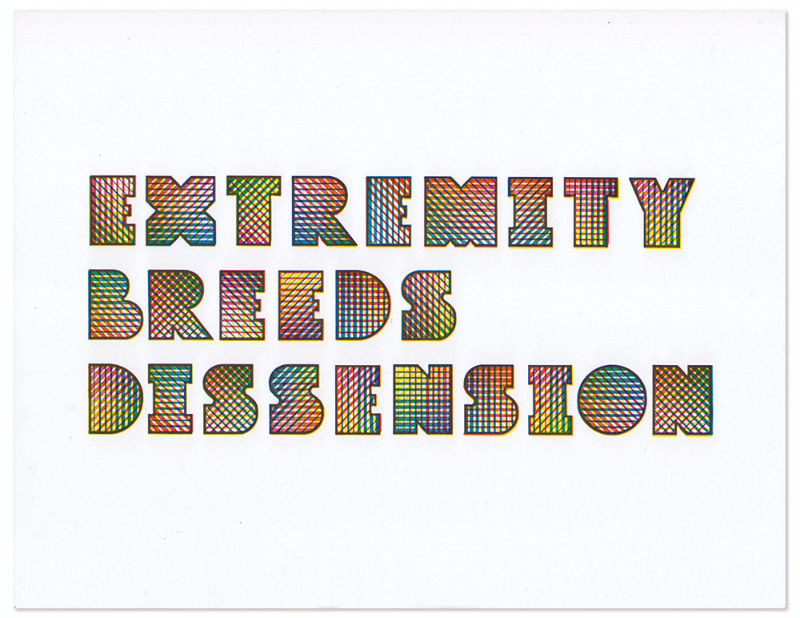
With Peripheral Technologies, curated by Thea Augustina Eck, the Ann Arbor Art Center continues its trend of bringing together a diverse group of voices who ask us, through their works, to reconsider the limits of fine art in an era when we are constantly being asked to do so.
The types of technology employed by the 12 artists -- and how they can be adapted for the creation of art -- are numerous, among them CNC (computer numerical control) machining, image scanning, computer-generated algorithms, and drone photography. Many artists pair emergent technologies with traditional or natural materials such as wood. These pairings create intriguing juxtapositions that ask viewers to consider our current technological moment in relation to manufacturing methods of the recent past. The artists come up with a different conclusion through methods, materials, and their finished works.
Contemporary Collage: "Odds & Ends" at the Ann Arbor Art Center
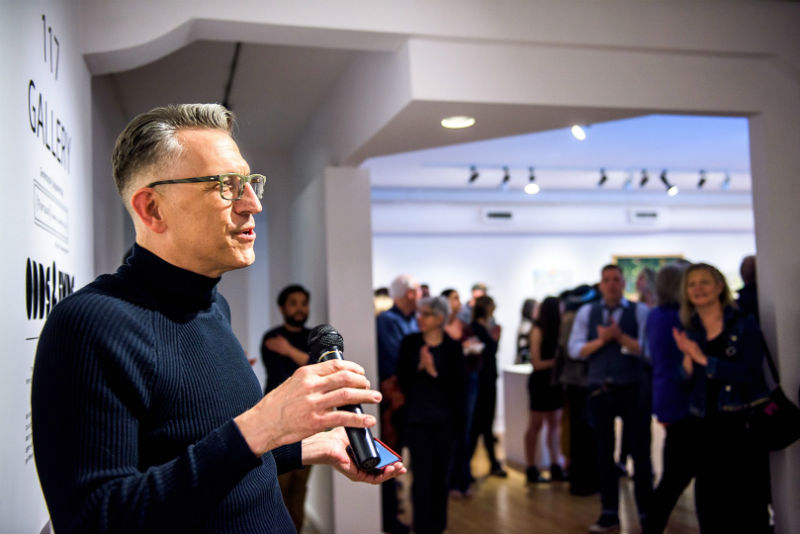
Ann Arbor Art Center’s latest juried exhibition centers on the art of collage. Aptly named Odds & Ends, the show brings together an array of works that represent contemporary artists’ engagement with the tradition. From mixed media to digital collage, Odds & Ends offers a diverse collection of accomplished works.
Ann Arbor artist John Gutoskey juried this exhibition. Gutoskey works as a designer, printmaker, and collector. He currently owns JG Studio and the A2 Print Studio in Ann Arbor. The Ann Arbor Art Center describes Gutoskey’s style of producing art and collecting by saying:
In the 1990s, John returned to his studio with a newfound interest in making art on his own terms, and it resulted in an outpouring of new work. Exploring the media of assemblage (through found objects), collage, printmaking, and installation, he was inspired by the works of Joseph Cornell, Betye Saar, Lucas Samaras, outsider art, Art Brut, and religious art to evolve his own unmistakable style: a perfect mirror for his gregarious, highly animated personality. The obsessive collector in Gutoskey met the trained visual artist half-way.
Gutoskey’s background in assemblage and collage is a perfect match for the content of this exhibition, which includes 2-D collage work, sculpture, mixed media works, and assemblage. Gutoskey selected winners for Best in Show, Second Place, Third Place, and three honorable mentions:
Bloodstained Economics: "Wang Qingsong / Detroit / Beijing" at UMMA explores class conflict in China and the U.S.
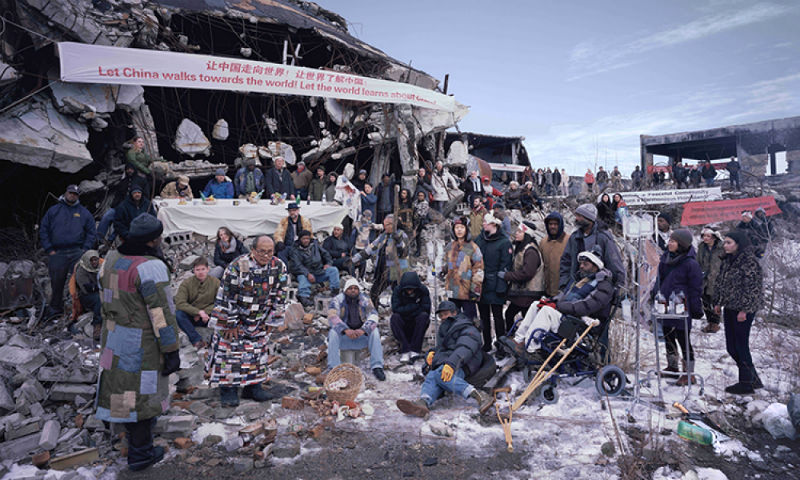
Wang Qingsong is interested in the effects of “rapid change in contemporary Chinese society.” He also sees a parallel in U.S. society, especially when it comes to the discrepancy between the haves and the have-nots, which is made clear in Wang Qingsong/Detroit/Beijing, his new exhibit at the University of Michigan Museum of Art,
Wang Qingsong restages the large-scale drawing The Bloodstained Shirt (1959) by Wang Shikuo, an iconic work of Socialist Realist art and one that celebrates land reforms in China after Communist victory in 1949. The original drawing depicts the peasant uprising against their cruel landlord and the subsequent reclaiming of the land.
In Wang Qingsong/Detroit/Beijing, Wang Shikuo's drawing forms the basis for a photo reenactment, shot in front of an abandoned Sanders candy factory in Highland Park, a city in Detroit. Wang Qingsong’s February 2018 restaging in Detroit raises questions about land use in the city while simultaneously commenting on current issues in China, which UMMA's curators note have shifted dramatically since the idealistic Wang Shikuo image was made. The curators also write that the artist originally intended to work in Beijing, where land redistribution suffers in favor of real estate developers’ interests.
Similarly, Wang Qingsong noticed that Southeast Michigan is driven by “private speculation on and the rebuilding of abandoned properties in Detroit and Highland Park that ignore the needs of most residents.” UMMA curators also note that the re-enacted The Bloodstained Shirt (2018) was intended by the artist to be shown both in China and the United States, but it is banned in China.
Across the Campus-verse: U-M's "Bookmarks: Speculating the Futures of the Book and Library" exhibit takes viewers on a trip

Right: Scheherazade 2.0 (prototype) by Osman Khan
The ambitious, expansive, multi-venue exhibition Bookmarks: Speculating the Futures of the Book and Library is currently displayed in three libraries across the University of Michigan’s campus. If you plan to see everything, expect to spend the day tracking them down through various academic libraries in Ann Arbor.
Many of the installations are true “pop-up” style, with the spaces being utilized by busy students. The exhibition, curated by Guna Nadarajan, dean of the Penny W. Stamps School of Art & Design at the University of Michigan, includes work by University students, faculty, and staff. The work can be viewed in three places: Hatcher Graduate Library, Art, Architecture & Engineering Library, and Shapiro Undergraduate Library.
The Bookmarks exhibition addresses two questions. First, many works engage with the shift from printed books to digital formats, the displacement of the book as a form, and shifting functions and perceptions of functions of the library. Second, artists question what these shifts in form mean for the institutions housing information. The exhibition asks: “What is the future of the library? What is the future of the book?” Each performance piece, artwork, or installation comment on speculative futures for books, libraries, or shifting technologies in unique ways.
In all, there are 14 site-specific installations and exhibits. Two of these require a cell phone or electronic device in order to experience the entire work.
Below, each work is listed under the library it is shown in, with specific instructions to find it.
The ManosBuckius Cooperative explore gender politics and the future of libraries in "TheMBC@TheLibrary"

The ManosBuckius Cooperative (The MBC) says the aim of its performance pieces is to “embrace purposelessness!”
Artists Melanie Manos and Sarah Buckius say this half-facetiously since their absurd performative art explores humanity’s relationship with technology: “Our aim is to energize a space with our activities, and suggest new interpretations for existing structures both in the social/political and environmental/architectural sense.”
The MBC's most recent collaboration, TheMBC@TheLibrary, took on the future of libraries and explored gender politics by disrupting the space in University of Michigan’s Art, Architecture & Engineering Library on Friday, April 12. The performance resulted in an installation that will remain on view until May 26 as part of the Bookmarks: Speculating the Futures of the Book and Library, a “multi-venue exhibition” curated by Guna Nadarajan of University of Michigan’s Penny W. Stamps School of Art & Design.
The performance will also be made available in the form of a final, edited video that compiles footage from the multiple cameras that recorded the bi-level performance piece. In general, the artists work in various media as part of The MBC, including “photography, mediated performances (live-feed to video monitor or projector), live performance with projections, videos, video installation with projections, and video installation with sculpture.”
Large-Scale Statements: "Abstraction, Color, and Politics in the Early 1970s" at UMMA
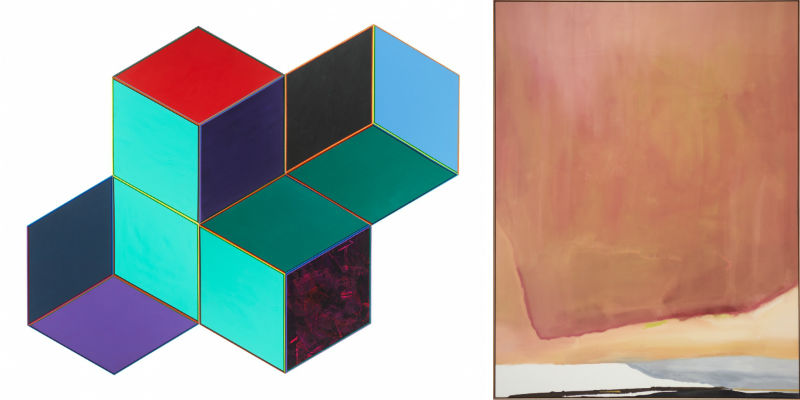
Right: Helen Frankenthaler, Sunset Corner, 1969, acrylic on canvas. University of Michigan Museum of Art, Museum purchase, 1973/1.813. © 2018 Helen Frankenthaler Foundation Inc. / Artists Rights Society (ARS), New York.
In the year-long exhibition Abstraction, Color, and Politics in the Early 1970s, the University of Michigan Museum of Art asks, “Can abstract art be about politics?”
The exhibition asks audiences to consider the once hotly debated status of abstract art almost 50 years later. Despite the gallery exhibiting only four pieces, the exhibition proves the abstract art of the 1970s has an ability to engage with major political themes then and now.
The move toward abstraction in art accelerated in the 1970s, and many artists turned to it in lieu of representational art. As UMMA points out, some were criticized for turning away from traditional means of representation. Critics suggested that abstract art could not be political, therefore believing artists to be intentionally disengaging with politics. At the same time, minority artists were challenging tenets of art history and institutions that promoted a specific set of standards in determining what “great art” was. Though some argued that abstraction was unable to convey political messages, the movement itself became political by deconstructing the status quo.
Expected Greatness: UMMA's "The Power Family Program for Inuit Art: Tillirnanngittuq" shows Ann Arbor's role in popularizing indigenous Arctic art
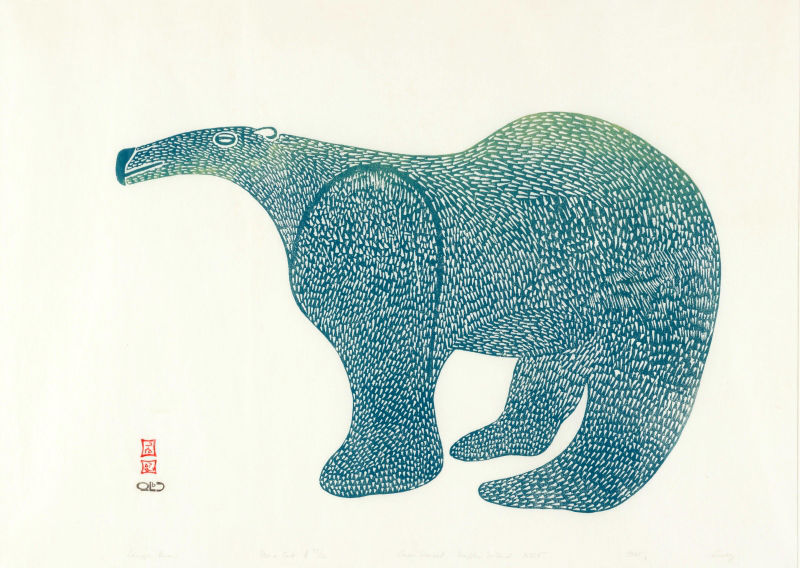
The influx of Inuit art in Ann Arbor began with Ann Arbor’s Eugene Power and Canadian artist James Houston. Power, a friend of Houston, became interested in the art and culture of Inuit peoples following his friend Houston’s research there, beginning in 1948. A decade later, Eugene Power and his son Philip founded a non-profit organization called Eskimo Art Inc. in Ann Arbor that operated as a wholesale distribution center for artworks imported from Kinngait (known then as Cape Dorset) Hudson Bay and Baffin Island. The organization sent profits to artists, funded art supplies, and organized artist training, including Japanese printmaking techniques. Inuit art continued to remain popular in the area, with Eskimo Art Inc. remaining open through 1994.
The Power Family Program for Inuit Art: Tillirnanngittuq exhibition includes many works that date to the beginning of the Power Family’s involvement with Inuit art and the subsequent creation of Eskimo Art Inc. Currently being shown at the University of Michigan Museum of Arts, the exhibition “celebrat[es] the exceptional gift of 20th-century Inuit art to the Museum by the Power family.” The exhibit features 58 works from the collection, which were promised as a gift to the museum in 2018. The title of the exhibition, Tillirnanngittuq, is the Inuktitut word for “unexpected,” referencing the tremendously positive public response to Canadian Inuit Art in Ann Arbor, and globally, beginning in the mid-20th century.
The State of the Art of Surveillance: "Blind House: Utopia and Dystopia in the Age of Radical Transparency"
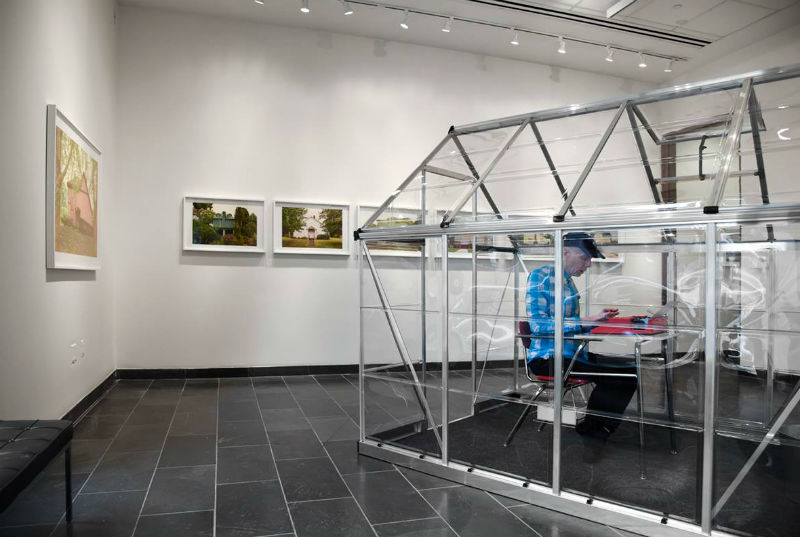
The Institute for Humanities Gallery is currently housing "Blind House: Utopia and Dystopia in the Age of Radical Transparency," a collaborative installation by artists Paloma Muñoz and Walter Martin. Along the walls are digitally altered photographs of the architectural exteriors of houses and in the center of the room a miniature glass house. There is a school desk in the center of the glass house, on top of which sits a red typewriter.
Visitors are free to enter the space, grab a blank sheet of paper from under the chair, and try to create their own utopia on paper. On the desk there are instructions for the visitor in English and Spanish: “1. Read and throw the existing utopia in the garbage. 2. Write your own utopia and leave it on the typewriter for the next participant. Please feel free to look through the garbage.”
In front of the desk, there is a trash can, which was filled with crumpled up, discarded utopias, demonstrating the past participation of gallery visitors in the work.
With Full CareForce: Marisa Morán Jahn's "The Mighty and the Mythic" at Stamps Gallery explores interactive, social-activist art

The Stamps Gallery's The Mighty and the Mythic is an interactive exhibit featuring the multi-faceted work of social activist and artist Marisa Morán Jahn. Curated by Srimoyee Mitra, this exhibition is an expansive collection with examples from three of Jahn’s ongoing projects. If you visit, make sure to give yourself plenty of time to view the many videos playing on TV screens around the gallery.
The three projects on display are CareForce (2012 to present), Biblobandido (2010 to present), and MIRROR | MASK (2017 to present). Though these are the artist’s solo projects, Jahn relies on the participation of her collaborators, who are often immigrants, domestic workers, and youths. Stamps Gallery notes that the work is infused with play and humor in order to portray her subjects’ lives with dignity, the ability to critique power, and to “build momentum within their communit[ies].” Jahn bases her practice on her own experiences as the child of first-generation Chinese and Ecuadorian immigrants.
David Opdyke's "Paved With Good Intentions" uses nostalgic imagery to critique modern politics

The Institute for Humanities at the University of Michigan launched its Year of Humanities and Environments with the exhibition Paved With Good Intentions by David Opdyke. The show consists of a full wall-sized installation of altered vintage postcards, two animated short videos, and two video channels rotating quotes by politicians. The three media serve to address similar subject matter: the current political climate in America. Climate is an operative word, as Opdyke’s work focuses in on the environment and climate change. His pieces criticize not only American culture but also inaction and stagnancy due to an unwillingness to find common ground. Using iconic, even nostalgic imagery on old postcards as a backdrop, our ideal of “America the Great” is challenged in numerous ways with Opdyke’s artistic interventions.
The gallery wall text, written by Institute for Humanities curator Amanda Krugliak, states, "David Opdyke’s installation Paved With Good Intentions up-ends any snapshots of family vacations, destination spots, and America the Beautiful still in our pockets.” Opdyke’s statement is printed below Krugliak’s and expands on the project. The massive work, titled This Land , was created with 528 postcards from “all across the United States" -- views of local and national parks, cities, rivers, bridges, lakes, landmarks, farms and wilderness -- assembled into a vast gridded landscape beset by environmental chaos.
The postcard collage creates an overall landscape, but upon close examination, there are many smaller dramas (or in this case, disasters) at play. As the grid reaches the bottom of the wall, postcards are falling in disarray, some having landed on the floor. Those that are on the floor reveal handwritten notes by their original owners, creating an eerie connection to people of the past, even as Opdyke’s overall project suggests a future plagued by increased disaster and chaos.


































